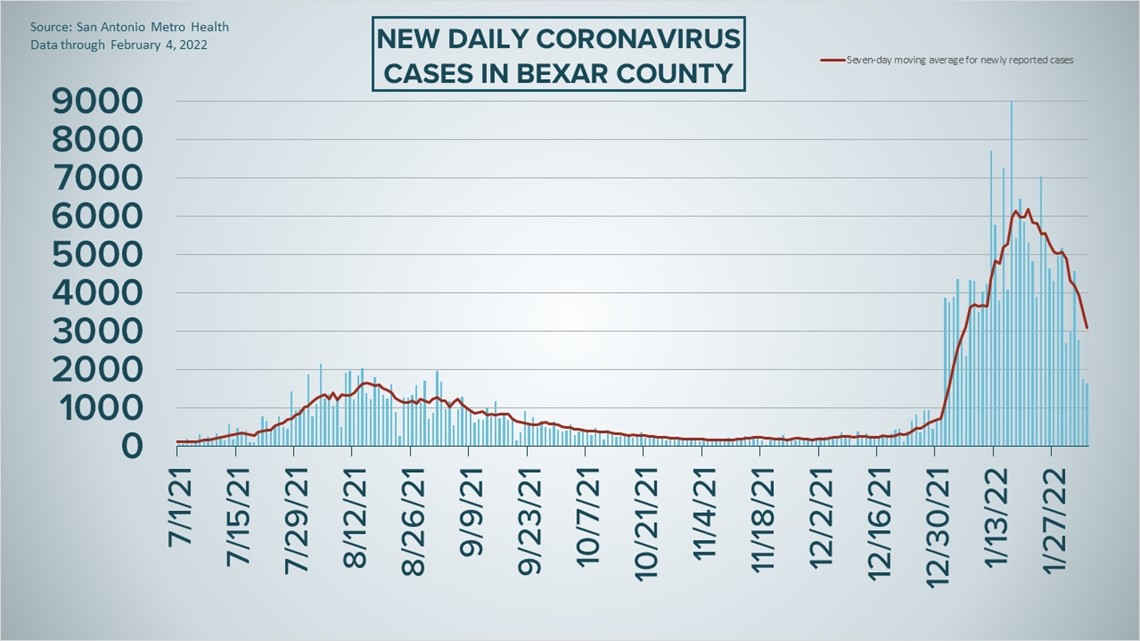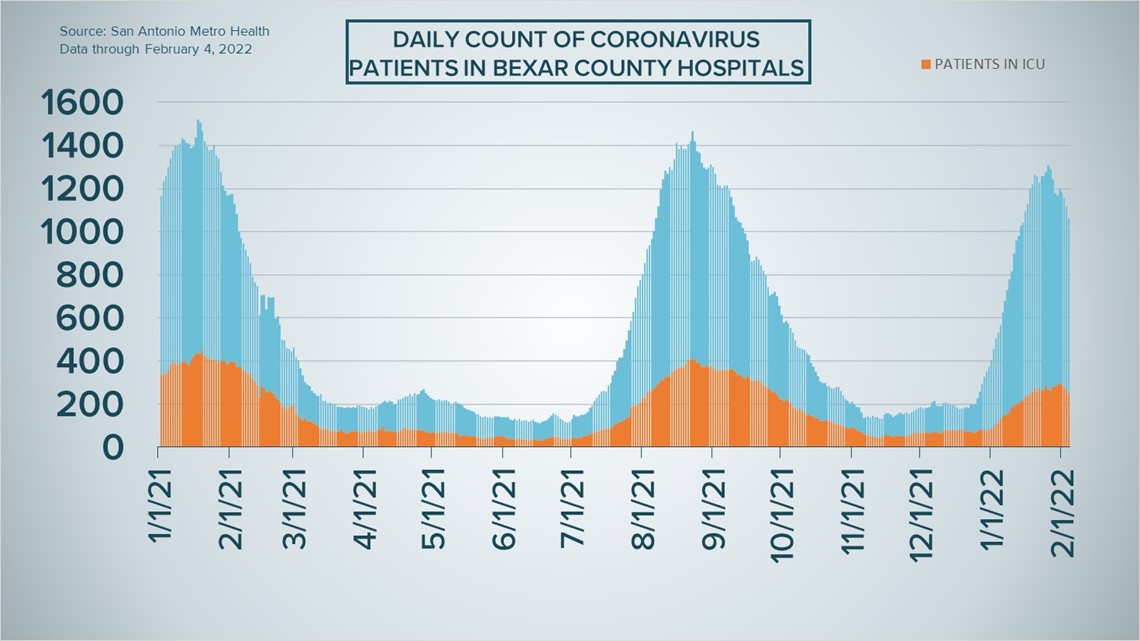SAN ANTONIO — Though Bexar County health authorities reported lower case totals to end the week – potentially a result of the arctic blast blowing through south Texas – the community on Friday surpassed 500,000 total COVID-19 diagnoses, a marker reached as the highly contagious omicron variant prolongs a pandemic which has dominated daily life for two years.
Metro Health tallied 1,642 new cases on Friday, bringing the total to 500,908. Nearly one in three cases affecting San Antonio-area residents have been reported in 2022.
The seven-day average for new cases has fallen to 3,081, the lowest that number has been since Jan. 5.
Hospitalizations, however, have fallen for four straight days, and the number of COVID-19 patients receiving treatment in local hospitals on Friday – 1,065 – is 180 fewer compared to last Friday. Of those 1,065 patients, 247 are in intensive care and 118 are using ventilators to help them breathe.
Here's where you can get free N95 masks from local pharmacies as part of the federal government's initiative to distribute millions of face coverings to Americans.
How Bexar County is trending




Vaccine Progress in Bexar County
The following numbers are provided by San Antonio Metro Health. A full breakdown can be found here.
- 1.732 million eligible Bexar County residents have received at least one dose of the coronavirus vaccine as of Thursday, Feb. 3.
- 1.406 million eligible Bexar County residents are fully vaccinated as of Thursday, Feb. 3.
The CDC states that "when a high percentage of the community is immune to a disease (through vaccination and/or prior illness)," that community will have reached herd immunity, "making the spread of this disease from person to person unlikely."
The City of San Antonio breaks down the vaccination rates by zip code on Metro Health's Vaccination Statistics page.
Coronavirus in Texas
The total number of coronavirus cases in the state since the pandemic began grew by 21,769 on Friday, according to the Texas Department of State Health Services. That total includes 16,495 new confirmed cases and 5,274 new probable cases. More details can be found on this page.
Friday's figures bring the total number of Texans diagnosed with COVID-19 to more than 6.33 million.
An additional 154 Texans have died from virus complications, meanwhile, raising the statewide death toll to 79,135.
Coronavirus symptoms
The symptoms of coronavirus can be similar to the flu or a bad cold. Symptoms include fever or chills, cough, shortness of breath or difficulty breathing, fatigue, muscle or body aches, headache, new loss of taste or smell sore throat, congestion or runny nose, nausea or vomiting, and diarrhea, according to the Centers for Disease Control.
Most healthy people will have mild symptoms. A study of more than 72,000 patients by the Centers for Disease Control in China showed 80 percent of the cases there were mild.
But infections can cause pneumonia, severe acute respiratory syndrome, kidney failure, and even death, according to the World Health Organization. Older people with underlying health conditions are most at risk.
Experts determined there was consistent evidence these conditions increase a person's risk, regardless of age:
- Chronic kidney disease
- COPD (chronic obstructive pulmonary disease)
- Obesity (BMI of 30 or higher)
- Immunocompromised state (weakened immune system) from solid organ transplant
- Serious heart conditions, such as heart failure, coronary artery disease, or cardiomyopathies
- Sickle cell disease
- Type 2 diabetes
- The CDC believes symptoms may appear anywhere from two to 14 days after being exposed.
Human coronaviruses are usually spread...
- Between people who are in close contact with one another (within about 6 feet).
- Through respiratory droplets produced when an infected person coughs, sneezes or talks. These droplets can land in the mouths or noses of people who are nearby or possibly be inhaled into the lungs.
- Some recent studies have suggested that COVID-19 may be spread by people who are not showing symptoms.
Help stop the spread of coronavirus
- Stay home when you are sick.
- Eat and sleep separately from your family members
- Use different utensils and dishes
- Cover your cough or sneeze with your arm, not your hand.
- If you use a tissue, throw it in the trash.
Find a Testing Location
City officials recommend getting a COVID-19 test if you experience fever or chills, cough, shortness of breath or difficulty breathing, fatigue, muscle or body aches, headache, new loss of taste or smell, sore throat, congestion or runny nose, nausea or vomiting, or diarrhea.
Here's a Testing Sites Locator to help you find the testing location closest to you in San Antonio.
Latest Coronavirus Headlines
- No, a scientific study doesn't say you can smoke marijuana to prevent COVID-19
- Olympic athletes have new anxiety: testing negative for COVID
- Yes, the Army is working on a universal coronavirus vaccine
- Yes, Spikevax and the Moderna COVID-19 vaccine are the same
- Yes, there are ways to determine if a KN95 or N95 mask is counterfeit
- Long COVID: Why does it happen? Who does it normally effect?
- Pfizer starting trials to create a vaccine specific to omicron variant

